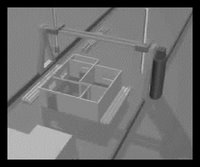Robots doing the Dirty Work
 Building Design has posted two exciting articles about an almost imaginary situation soon to face architects. There are two major research institutes ready to deliver robots that "print" whole buildings directly from designers' three dimensional computer models.
Building Design has posted two exciting articles about an almost imaginary situation soon to face architects. There are two major research institutes ready to deliver robots that "print" whole buildings directly from designers' three dimensional computer models.There have been several methods of robo-construction proposed over the years, and a favorite has been the distributed-system method that other researchers (not related to BD articles) have been tinkering with. Distributed systems are characterized by one large task being divided into smaller tasks, and a team of communicating agents completing the aggregated work without necessarily knowing the larger stratagy. This seemed a far more clever and versatile system than having a giant 3d printer slowly excrete a design, but until now such statements were critiques of science fiction.
The prospect is exciting because of the series of crises that cheap, mechanical construction threatens to bring. Remember your high school history classes describing the way shifts of power necessitated balance-restoring wars throughout European history? Similarly, the Vitruvian Triad suggests Architecture is a balance of firmness, commodity, and delight. The technology Building Design highlights will threaten to deliver firmness and an economy of building very simply. How will this effect delight? This question may have thousands of very familiar instantiations... "If any wavy-gravy form is strong and cheap, why make this particular one into the house?" "If we can print thousands of interlocking houses, which pattern of interlocking housing types make the best neighborhoods?" "Is a printed house somehow more, or less valuable than a hand-made one of similar design?" "Where is the craft in this?"

1 Comments:
First thoughts:
When will the robots start to design as well as construct?
If a robot can pass the Turing test, what rights does it have, compared with human rights?
Robots may not need a union, get tired or need tea breaks, but can you sue them if they get it wrong or don't deliver on time?
Extremely interesting area to blog on about for years.
Post a Comment
<< Home